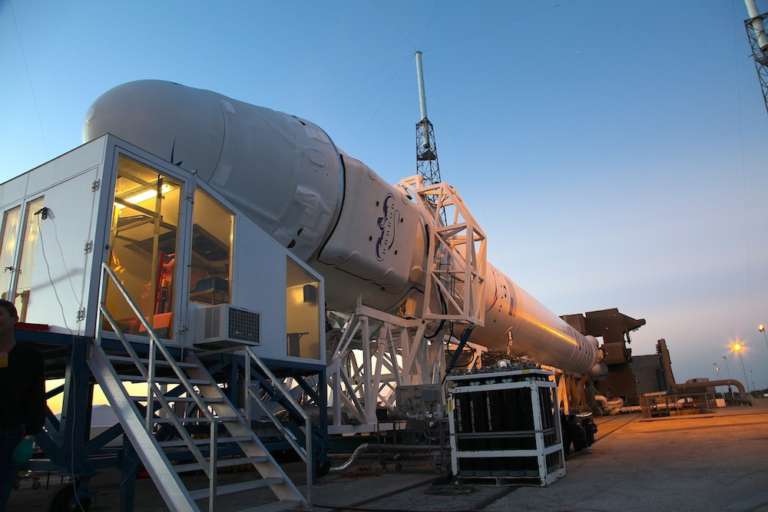Jason Davis • Mar 01, 2013
Dragon reaches orbit, but experiences propellant valve issue
Update: 3:45 p.m. EST
NASA has concluded a press conference updating Dragon’s status.
Dragon is equipped with 18 Draco thrusters organized into four pods. Two pods have four thrusters, and the other two have five. The thrusters are powered by eight propellant tanks. Four contain fuel, and the other four contain oxidizer.
SpaceX CEO Elon Musk says that when Dragon was released by the Falcon 9, only one of the oxidizer tanks was showing nominal pressure. The current theory is that blockages formed in the pressurization lines leading to the oxidizer tanks, but Musk cautioned that it is too early to say for sure. SpaceX has been able to cycle valves to free the suspected blockages, and all four thruster pods are back online. As of now, only two pods are engaged, but Musk estimates this will be corrected within the hour.
This will delay Dragon’s arrival at the station by at least one day. NASA and SpaceX are optimistic the problem will be resolved in time for a Sunday berthing. If not, station managers stress there is a wide timeframe to work with, and they will not proceed until they are satisfied Dragon can show it has the necessary redundancies in place to safely approach the ISS.

This time, however, a problem occurred on Dragon itself just after it drifted away from the Falcon’s upper stage, and SpaceX abruptly ended their launch coverage.
"It appears that, although it achieved orbit, Dragon is experiencing a problem right now," said John Insprucker, Falcon 9 Product Director. SpaceX CEO Elon Musk continued to provide updates as the situation developed.
Issue with Dragon thruster pods. System inhibiting three of four from initializing. About to command inhibit override.
— Elon Musk (@elonmusk) March 1, 2013
Holding on solar array deployment until at least two thruster pods are active
— Elon Musk (@elonmusk) March 1, 2013
About to pass over Australia ground station and command inhibit override
— Elon Musk (@elonmusk) March 1, 2013
Thruster pod 3 tank pressure trending positive. Preparing to deploy solar arrays.
— Elon Musk (@elonmusk) March 1, 2013
Solar array deployment successful
— Elon Musk (@elonmusk) March 1, 2013
SpaceX then released a statement saying a thruster propellant valve was the cause of the problem. The company said that although one thruster pod is up and running, they require two to begin a series of burns to proceed towards the International Space Station.
Dragon is scheduled to arrive at the station on Saturday, March 2. It will perform a series of height adjust burns to bring it within 2.5 kilometers of the station. Following a go-ahead from NASA, Dragon will close to 10 meters, at which point station commander Kevin Ford will grapple the spacecraft with Canadarm2, the station’s robotic arm. Flight Engineers Tom Marshburn and Chris Hadfield will also provide assistance.
Dragon’s back-to-back flight problems will likely focus renewed scrutiny on the burgeoning private spaceflight company. During Falcon 9’s CRS-1 flight on October 8, 2012, engine number one failed in dramatic fashion approximately one minute, 19 seconds into flight. Dragon’s ride to the ISS was unaffected, but a secondary payload for satellite company Orbcomm was deployed into a lower-than-required orbit. It eventually tumbled back into Earth’s atmosphere (PDF).
At a press conference Thursday, SpaceX president Gwynne Shotwell offered few details about the previous engine failure, saying the cause was a material flaw in the engine’s protective jacket. According to SpaceflightNow, Shotwell said she could not offer further details because the launch report is under review by the U.S. State Department. She also said that the exact composition of the failed material could not be disclosed due to export control laws.

Once Dragon is successfully grappled, it will be berthed to the station’s Harmony module. Hatch opening is currently scheduled for Sunday, and Dragon’s cargo will be unloaded over the next few weeks. NASA shows a scheduled Dragon return date of March 25.
Support our core enterprises
Your support powers our mission to explore worlds, find life, and defend Earth. You make all the difference when you make a gift. Give today!
Donate

 Explore Worlds
Explore Worlds Find Life
Find Life Defend Earth
Defend Earth

